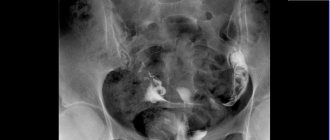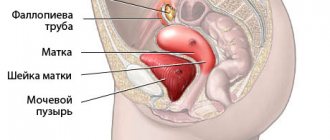What symptoms may indicate tubal obstruction?
Despite the fact that testing the patency of the fallopian tubes is a mandatory step in diagnosing any form of infertility, there are certain symptoms that can tell the clinic doctor that the reason for the failure to get pregnant is a problem with the tubes. The likelihood of tubo-peritoneal infertility is higher if the following symptoms are present:
- History of frequent inflammatory processes of the pelvic organs. These conditions are manifested by pain in the lower abdomen, increased body temperature, the presence of vaginal discharge, menstrual irregularities, and discomfort during sexual activity.
- Positive results of PCR diagnostics for sexually transmitted infections. The insidiousness of these conditions is that for a long time they occur without any symptoms, or the manifestations are so insignificant that neither the man nor the woman pays attention to them. However, the pathological process in the body has started, and gradually the patency of the fallopian tubes will be disrupted, because these pathogens often damage the columnar epithelium that lines the pipes from the inside.
- Previous operations on the pelvic organs. Adhesions that form in response to surgery can put pressure on the tubes from the outside. On the one hand, this disrupts their mechanical patency, and on the other, it changes peristalsis. As a result, the egg is never able to meet the sperm.
Diagnostic results: interpretation of images
The contrast agent does not transmit x-rays, and the cavities filled with it are visible on the image as bright white spots. An indicator of good tube patency is the spreading of the contrast agent along the peritoneum to areas remote from the insertion site. If the contrast stops at any section of the fallopian tube, it means that there is an adhesion or other pathology in this place. Depending on the shape of the uterus and tubes, the doctor can determine which pathological process is preventing conception. Interpreting images of the uterus and fallopian tubes requires extensive knowledge and considerable practical experience. Self-diagnosis is a completely useless exercise.
If the results of the examination give reason to suspect the presence of uterine cancer, it is necessary to order additional examinations, including taking tissue for a biopsy. The diagnostic doctor's conclusion, along with the photographs, is transmitted to the attending physician who referred the woman for examination.
Interpreting images of the uterus and fallopian tubes requires extensive knowledge and considerable practical experience. Self-diagnosis is a completely useless exercise.
When is the procedure necessary?
It is recommended to check the patency of the fallopian tubes in all cases of infertility. In other words, if a woman is under 35 years old and conception does not occur within 1 year, then this is a reason to contact a gynecologist to determine the cause of impaired fertility. If a woman is over 35 years old, the waiting period is reduced to six months. If after 6 months the long-awaited pregnancy has not occurred, then it is necessary to begin an examination. The program for diagnosing the causes of infertility includes a set of measures, incl. checking the patency of the fallopian tubes.
These deadlines are clearly defined, because You cannot waste precious time, because with each menstrual cycle the reserves of eggs in the ovaries only decrease. Once the cause of infertility is determined, treatment is carried out. If even after this the couple is unable to get pregnant, then this is a direct indication for the use of assisted reproduction methods, among which IVF occupies a leading position. It is worth noting that the tubo-peritoneal factor of infertility shows the best results in relation to assisted reproductive medicine. The success rate is quite high compared to other forms of infertility.
Indications and contraindications for hysterosalpingography
Typically, an examination is prescribed to diagnose the causes of infertility.
An HSG can be done in a clinic, having previously received a referral from a gynecologist. Typically, an examination is prescribed to diagnose the causes of infertility. The procedure is performed if, in the absence of contraception, a woman under 35 years of age for a year or over 35 years of age for six months cannot become pregnant.
Diagnostics is also necessary if you suspect:
- disorders of the anatomical structure of the uterus and appendages
- fibroids
- adhesions
- polyps and other pathologies
Indications for fallopian tube HSG are determined by the doctor as part of a survey and examination of the patient, as well as after other examinations.
In some cases, no diagnosis is made.
The procedure should be postponed if:
- Pregnancy. It is necessary to limit sexual contact or use contraception for a month before the procedure
- Allergies to contrast agents. During diagnosis, iodine-containing substances are used. They can provoke an acute reaction from the woman’s body
- Bacterial and infectious diseases
- Inflammatory processes (especially in the acute stage)
The final decision on the advisability of fallopian tube HSG is made by the doctor. This allows the procedure to be as safe as possible.
Diagnosis is also refused for uterine bleeding, thrombophlebitis and some other pathologies.
Important! The final decision on the advisability of fallopian tube HSG is made by the doctor. This allows the procedure to be as safe as possible.
Methods for determining the patency of the fallopian tubes in women
Answering the question of how to check the patency of the fallopian tubes in women, in principle all existing methods are divided into 2 categories:
- Preoperative is an assessment using either x-ray scanning or ultrasound waves. In the first case, the study is called metrosalpingography (Hysterosalpingography), and in the second, echohysterosalpingoscopy.
- Intraoperative – laparoscopic chromohydrotubation. During laparoscopy, the doctor evaluates the time and characteristics of the flow of contrast through the fallopian tubes.
Intraoperative assessment is considered the most reliable method. However, this option is associated with an invasive procedure, so it is carried out only if there are strict indications.
The initial assessment of tubal patency in women is carried out using non-invasive methods. It is worth considering that up to approximately 10-25% of cases will not reflect the true picture. This can be when in the normal state the pipes are actually not passable, or a false impression of supposed blockage of the pipes, which in the usual state function normally. Such features of non-invasive diagnostics may be associated with the reaction of the woman’s body to the injected contrast, to fixation of the cervix and other circumstances.
In doubtful cases, laparoscopy makes the final diagnosis. It is especially recommended to carry it out before the IVF program. If the fact of absolute inferiority of the fallopian tubes is confirmed in a couple, then it will be possible to immediately perform an operation to remove them. This will avoid ectopic pregnancy, which often occurs with IVF if the anatomy of the tubes is disturbed.
IVF for tubal obstruction
However, it is most often not possible to restore the functionality of the fallopian tubes, namely the ability of the villi that line the inner layer of the tube to propel a fertilized egg into the uterus. Moreover. It is for this reason that the risk of ectopic pregnancy after laparoscopic tubal interventions increases. Our reproductive specialists will conduct a full diagnosis, after which they will assess the patient’s chances of a natural pregnancy and develop treatment tactics.
IVF in the case of tubal factor has the highest chance of ending in pregnancy from the very first protocol. In this case, if the medical history is not burdened by any other diseases, a classic IVF program with stimulation is proposed. The patient is sequentially injected with hormones, causing the maturation of several dominant follicles in the ovaries. Most likely, the patient will be recommended a short stimulation protocol, which reduces the overall treatment time and reduces the hormonal load. Using a long protocol allows you to obtain a larger number of eggs, which means a greater chance of obtaining high-quality embryos. After puncture of the follicles, which takes place under general sedation, the oocytes are fertilized with the partner’s sperm, then the embryos are cultured in a Petri dish until day 5 and transferred to the expectant mother in an amount of 1-2. The remaining embryos are preserved by vitrification until the couple decides to come to the clinic for a second or even third child. If a couple wants to carry out preimplantation genetic diagnosis of embryos or for some reason the doctor prescribes a cryoprotocol for the couple, the embryos are also preserved and stored in our cryobank until transfer.
To make an appointment with a fertility specialist, please call the numbers indicated, leave a request on the website below or write to us via online chat.
How to prepare for the procedure?
Preparation for the tubal patency procedure includes standard examinations:
- general clinical blood test;
- general clinical urine analysis;
- blood chemistry;
- gynecological smear to determine vaginal microflora;
- analysis for blood-contact infections - HIV, syphilis, hepatitis B and C;
- conclusion of a therapist in the presence of chronic diseases.
At the preparatory stage, the gynecologist excludes possible contraindications. The latter include:
- current pregnancy;
- acute inflammatory processes of any localization;
- bleeding from the uterus of unknown pathology;
- allergy to contrast agents used in the diagnostic process;
- diseases of internal organs in the stage of decompensation.
Contraindications
Despite the obvious effectiveness of the method of treating the disease, blowing is not recommended for:
- Mud treatment or less than two months from the date of its completion;
- Malignant neoplasms of the uterus and its appendages;
- Individual immunity to medications recommended for use during the procedure;
- Bloody discharge from the cervical canal;
- Less than four months from the development of acute inflammatory processes of the reproductive system;
- Presence of bacteria, fungi or viruses. The most common include: staphylococci, streptococci, E. coli bacteria, the presence or absence of which also determines the level of vaginal cleanliness;
- The beginning of the menstrual cycle;
- Suspicion of pregnancy;
- Development of general or local inflammatory processes;
- A sharp jump in ESR levels in the blood, leukocytosis;
- A sharp increase in body temperature;
- Severe pathologies of the cardiovascular system;
- Alkaline environment of the vaginal smear;
- Cervical erosions.
Many people are concerned about the question: does blowing the fallopian tubes help? If the doctor, after all the research, recommends undergoing the procedure, it helps. This is a technique that has been tested over the years and has helped more than one woman.
Why does tubal obstruction occur?
The main reasons leading to obstruction of the fallopian tubes are the following conditions:
- previous operations on the abdominal and pelvic organs, incl. appendectomy;
- previous inflammatory diseases of the pelvic organs – adnexitis, oophoritis;
- urogenital infections with sexual transmission;
- endometrioid disease is a condition in which cells of the uterine mucosa are found outside the uterine cavity, incl. in the fallopian tubes, on the pelvic peritoneum;
- abnormal development of the genital organs;
- functional disturbance of fallopian tube peristalsis and other pathological conditions.
Types of purging
In modern medicine, there are two types of blowing and each of these types differs in a number of features in its implementation.
Perturbation is the process of purging with carbon dioxide. The latter is best suited because it has a high dissolution rate in the bloodstream.
In addition, it includes a number of features:
- Before starting the procedure, it is important to empty the bladder and cleanse the intestines through the use of an enema;
- Carried out by a specialist. In this case, special equipment is used, connected to a container filled with gas. Using a rubber tube with a tip inserted into the cervical canal, gas is supplied;
- Before the procedure, the external genital organs are treated with a disinfectant solution. Then the tip of the device is installed and fixed and gas supply begins. This must be done with extreme caution; feeding too quickly can lead to damage to the integrity of the internal organs;
- If the patency is normal, air will enter the abdominal cavity without any problems. This can be noted by the drop in pressure level on the pressure gauge installed on the device that supplies air. In addition to changes in the pressure gauge readings, there will be a clearly audible noise in the peritoneal area. This is the result of air movement.
There is no need to worry that this type of intervention may cause injury to the inside of the uterus or fallopian tubes. When performing it, low pressure is used, which has a gentle effect on the internal genital organs.
Hydroturbation is the process of purging through the use of isotonic saline sodium chloride solution.
Mostly similar to perturbation. However, an important difference is the fact that the diagnosis of patency is carried out by blowing with liquid. The latter, like air, is supplied under slight pressure.
One of the differences between these measures is the fact that perturbation is used mainly for diagnosing pathology, and hydroturbation for therapy. Thus, the liquid that enters the body helps restore the normal functioning of the woman’s reproductive system.
Today, the procedure is carried out after lapatoscopy on the fallopian tubes, as a means of monitoring the patient’s condition in the postoperative period. Thus, it helps prevent the development of inflammatory processes and adhesions.
The water blowing procedure includes a number of features:
- Immediately before her, the woman must undergo a series of preparatory cleansing procedures;
- In an outpatient clinic, a specialist uses a syringe or a special device to inject a special mixture into the uterine cavity. Most often it is an isotonic saline solution or a mixture of novocaine with steroid medications. The choice of means is determined by the purpose of the procedure. So, for example, if such washing is necessary to treat adhesions and eliminate scars, a special enzyme is included in the liquid - lidase;
- Next, the specialist must assess the patient’s condition based on fluid movement. If the patient has developed partial obstruction, the flow of solution into the uterine cavity will occur very slowly. When full, the flow of fluid will be accompanied by gradually increasing pain in the groin area. Unpleasant feelings will increase in accordance with the increase in the force of pressure of the mixture on the walls of the organs.
If hydroturbation was carried out using a special device, the gynecologist can immediately determine the condition of the pipes based on the readings of sensors installed on the device. Their readings will change in accordance with fluctuations in pressure force.
In modern medicine, two types of blowing are used: perturbation and hydroturbation. Basically, the first method is used for diagnosis, and the second method is used for treating pathology.
Diagnostic options
- 1. Assessment of patency using ultrasound - echosalpingography.
A thin catheter is inserted into the uterine cavity through the vagina and cervical canal, through which contrast or saline solution is supplied. The fluid gradually enters the fallopian tubes, and then into the abdominal cavity. Based on the time and nature of admission, it is determined whether the patency of the fallopian tubes is impaired. The advantage of the method is that it does not require fixation of the cervix with bullet forceps, which means there is no reflex spasm of the fallopian tubes. In addition, the procedure is quite well tolerated; it is extremely rare to experience discomfort associated with stretching of the tubes.
- 2. Assessment of patency using x-ray hysterosalpingography.
Iodinated contrast is injected, after which a series of x-rays are taken. This technique involves a certain amount of radiation exposure and is not applicable for those patients who are allergic to iodine. The patient still has images in his hands that can be re-evaluated. During the examination, moderate pain may occur.
- 3. Laparoscopic assessment.
This is the most reliable method. However, due to its invasiveness, it cannot be used as a screening test. Such an assessment involves a full-fledged surgical intervention, in which the surgeon visually assesses the condition of the fallopian tubes and ovaries, and then the time of entry of methylene blue into the abdominal cavity (contrast is introduced through the cervical canal).
All options for assessing tubal patency are performed in the first phase of the menstrual cycle. In the month when such a diagnosis is carried out, reliable contraception is required. There are frequent cases of pregnancy when peristalsis is impaired, and there are no serious organic changes. Typically, conception can occur in the next 1-2 cycles.
How is the HSG procedure performed?
The examination is carried out in a specially equipped room. The room is equipped not only with a gynecological chair, but also with an X-ray machine.
The examination is carried out in a specially equipped room. The room is equipped not only with a gynecological chair, but also with an X-ray machine.
The HSG procedure of the fallopian tubes, like any other in medicine, is carried out in several stages:
- The patient is positioned on the x-ray table
- The doctor inserts gynecological speculum into the vagina and carries out antiseptic treatment
- A special catheter is inserted into the cervical canal, through which a contrast agent is supplied to the uterine cavity.
- After the uterus fills with fluid, the doctor takes pictures and monitors the passage of contrast through the fallopian tubes
This completes the procedure. The doctor begins to evaluate the results obtained.
As part of the diagnosis, a woman may experience slight discomfort. Immediately after the examination, the patient can go home or return to her usual activities.
After HSG, the following are possible:
- small discharge (sacral) from the genital tract, lasting a maximum of 2-3 days
- slight nausea
- pulling sensations in the lower abdomen, comparable to painful menstruation
- slight weakness and dizziness
These side effects are normal. They are provoked by the intervention, but are not dangerous to the health and life of the woman. To eliminate discomfort, the patient may be recommended special medications for pain relief and spasm relief.
To eliminate discomfort, the patient may be recommended special medications for pain relief and spasm relief.
Important! Medicines are prescribed exclusively by a doctor.
Also, in the first few days after the HSG procedure of the fallopian tubes, you should refrain from physical activity and sexual intercourse, as well as from visiting the bath, bathhouse and sauna.
Important! If the temperature rises, bleeding increases or other side effects occur, you should immediately seek medical help!
Treatment options for blocked fallopian tubes
If the fallopian tubes are blocked by fluid, the most likely cause of this condition is urogenital infections. However, even despite the identification of the pathogen, it is not always possible to achieve the desired result. Conservative treatment, especially with a long-existing process, turns out to be ineffective, because the pathological process leads to irreversible consequences. A similar situation can develop with endometriosis and adhesions. In such a situation, the only way out is a tubectomy (removal of the fallopian tubes) and IVF to achieve pregnancy. The task of preliminary removal of pathologically altered tubes is to prevent ectopic implantation of the fertilized egg.
Assisted reproductive technologies for tubal obstruction are an effective method of treating this form of infertility. And the earlier IVF is performed, the higher the effectiveness of this procedure.
What is the essence of this survey?
Hysterosalpingography is a method of visualizing the fallopian tubes and the uterine cavity, based on filling their lumen with a specially injected fluid. The doctor records the nature of its distribution using equipment, and then analyzes the resulting images.
HSG provides the specialist with reliable information about the patency, location and size of the fallopian tubes. Various deformations, adhesions and neoplasms in the uterine cavity can also be detected. In this case, the patient will be recommended for additional targeted examination in the clinic.
Previously, X-rays with additional contrast enhancement were used for tubal HSG. This method is still used today, although it has a number of disadvantages. Therefore, currently in St. Petersburg, preference is given to an alternative safe technique - contrast ultrasonic hysterosalpingoscopy (CUUSGSS).
X-ray contrast hysterosalpingography is associated with additional (albeit small) irradiation of the patient’s pelvic organs, so it is advisable for her to refrain from becoming pregnant for the next 3 cycles. In addition, the drug used may be toxic or cause an allergic reaction. The ultrasonic method does not have such disadvantages. After all, in this case, the uterine cavity and fallopian tubes are filled with a sterile saline solution that is neutral for the woman’s body, and the ultrasonic waves emitted by the sensor are completely safe and do not cause discomfort.
What to do after diagnosis
The liquid introduced during HSG is excreted independently through the vagina, so after the procedure it is advisable for a woman to use a pad. For several days, a woman may experience moderate stretching and heaviness in the lower abdomen and in the projection of the ovaries; this is acceptable and does not require urgent consultation with a doctor. To reduce such sensations, it is usually sufficient to take antispasmodics and non-narcotic analgesics (painkillers); this point must be clarified in advance with a gynecologist.
For 3 days after the examination, it is not recommended to use tampons and vaginal devices for collecting secretions (menstrual cups). You should also refrain from douching, intimate relationships, bathing, visiting baths and saunas.
Where can I get an HSG done?
You can check pipes for permeability in St. Petersburg in many institutions that have the necessary equipment and certificates. But when choosing a clinic, you should take into account that modern ultrasound hysterosalpinoscopy is not used everywhere. And the reliability of the results largely depends on the qualifications of the doctor and the quality of the equipment. Therefore, whenever possible, preference should be given to modern, well-equipped medical centers.
In St. Petersburg, the necessary examination can be completed at the ICLINIC Reproductive Medicine Clinic. We specialize in the diagnosis and treatment of various forms of marital infertility, using modern, highly effective and proven methods and high-class equipment.
Testing of the fallopian tubes in ICLINIC is carried out using contrast ultrasonic hysterosalpingoscopy (CUUSH). This is an important modern diagnostic tool that allows you to quickly, safely and with a minimal degree of invasiveness assess the patency of the tubes and the likelihood of a natural successful conception.
After examination at ICLINIC, the patient receives a qualified expert opinion and has the opportunity to consult with experienced reproductive specialists. Our doctors will help you undergo the necessary examination and choose the optimal infertility treatment regimen.
Organ structure
The inside of the fallopian tube is lined with ciliated epithelium. The organ wall consists of four layers:
- Serous - comes from the peritoneum;
- Subserous - loose tissue with blood and lymphatic vessels, smooth muscles;
- Lamellar – connective tissue;
- Epithelial.
The shell contains the most ciliated cells; the growth of villi on them is activated by extragen. Sensory cells contain granules that produce fluid. It serves as a source of nutrients for the egg and sperm. The number of such cells is influenced by progesterone.








